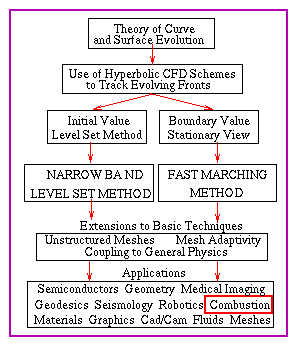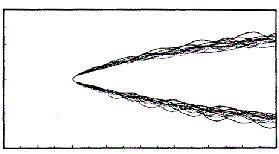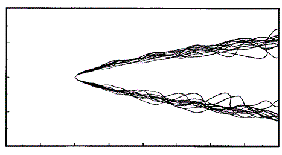OVERVIEW
APPLICATIONS
INTERACTIVE APPLETS
HISTORY OF THE METHODS/FLOW CHART
PUBLICATIONS
EDUCATIONAL MATERIAL
ACKNOWLEDGEMENTS
ABOUT THE AUTHOR/CV
Copyright:
1996, 1999, 2006
J.A. Sethian
Applications to Combustion
You are currently in the
topic outlined in red.

Click on navigable flow chart to go to new topic
click on any text
to go to a new topic.
|
You are currently in the topic outlined in red. |

Click on navigable flow chart to go to new topic |
click on any text to go to a new topic. |
A level set view of these combustion phenomena views the flame front as the zero level set of a level set function. The jump conditions along the flame front, which result from exothermic expansion, create an additional velocity field, as does the baroclinic term. The flame speed depends on a local burning velocity as well as the mitigating effects of curvature (this is a flame model similar to that suggested by Markstein).
Annotated References:
-
Ref. 1 links paper to apply level set methods to combustion;
it couples projection methods for fluid flows to the problem of
tracking a cold flame in a swirling fluid. This is paper couples projection
methods and Navier-Stokes solvers to level set
interface techniques; in these calculations,
there is no back-coupling between the flame motion and the
flow dynamics.
- Ref. 2 build a more complete flame model, and studies the turbulizing effects of a flame motion in a hydrodynamic field. The model studies exothermic heat release, flame-induced vorticity generation, solid wall boundary conditions, upstream fluid turbulence, curvature-modified flame speeds, and the combined effects on flame brush and stability.
Examples:

|

|
New Book and Resource on Level Set and Fast Marching Methods
References:
-
Projection Methods Coupled to Level Set Interface Techniques
: Zhu, J., and Sethian, J.A.,
Journal of Computational Physics, 102, pp.
128-138, 1992.
Abstract
In this paper, we merge modern techniques for computing the solution to the viscous Navier-Stokes equations with modern techniques for computing the motion of interfaces propagating with curvature-dependent speeds. The resulting algorithm tracks the motion of an evolving interface in a complex flow field, and easily handles complex changes in the front, including the development of spikes and cusps, topological changes and breaking/merging. As examples, we apply the resulting algorithm to interface boundaries in a driven cavity and in a shear layer, and cold flame propagation in a hydrodynamic field.
Download publications
-
Dynamical Study of a Premixed V flame
:
Rhee, C., Talbot, L., and Sethian, J.A., Journal of Fluid Mechanics,
300, pp. 87-115, 1995.
Abstract
Download publications